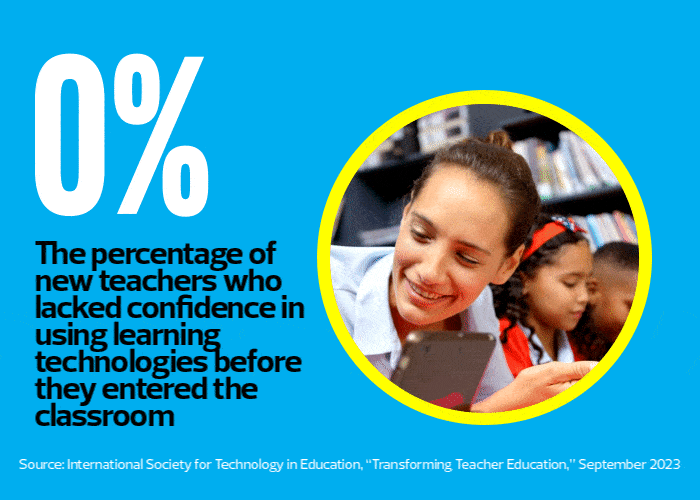EDTECH: The NETP recommends that states and districts establish a cabinet-level educational technology director role to oversee funding. How could this help to address digital access?
WEAVER: Having a CTO or director of ed tech at the senior level is critical. However, districts can’t rest their tech integration and digital transformation goals on that role alone. Digital access and integration must be a shared understanding, mindset and responsibility across all senior-level roles.
MIYASHIRO: When I started at Cajon Valley, one of the first things I asked for was a CTO. It took us roughly two and a half years to rebuild an antiquated technology system into an interoperable system, but because our CTO is at the cabinet level and sits with other assistant superintendents in our weekly meeting, it was seamless to move forward.
Many tech directors have their hands tied because they don’t have authority to do anything without permission. That layer of bureaucracy is hard to overcome.
DISCOVER: Improve the superintendent and technology leader relationship.
EDTECH: The goal of moving students from passive to active uses of technology was also addressed in the 2016 NETP. How could schools eradicate this gap permanently?
WEAVER: Teaching in most classrooms is generally a one-directional experience, where teachers use direct instruction as the primary mode for learning delivery. We think the NETP is attempting to push the education community to embrace the role technology and research-based pedagogy should play in the current — and next — iteration of public education. When school leaders understand the research-based pedagogical practices that actually move the needle, then schools can see that powerful learning and the use of technology go hand in hand.
BELASTOCK: By looking at data, whether through classroom observations or formative and summative assessments, you can see which tools are engaging our students effectively. It makes no sense to have multiple tools that are more of a “sit and get” or a time-filler in classrooms. That’s a big ask, but I think some districts are doing it.
DIG DEEPER: Schools are turning to modern data platforms to support learning goals.
EDTECH: The NETP acknowledges that professional learning is crucial. How does that relate to the digital design and digital use divides?
BELASTOCK: This document talks a lot about the portrait of a learner and the portrait of an educator, so if we don’t train our staff on what that looks like, these digital divides will continue.
Professional development also needs to include data-driven decision-making. Our educators are in classrooms of 20 or 30 students, and as IT directors and CTOs, we struggle to understand the demographics of those classrooms. In working on professional learning, we can make sure to address marginalized students, ELA [English Language Arts] students, students with disabilities and all of those different areas.
CHELETTE: We learned during the pandemic that computers are useless bricks unless somebody knows how to use them. Teachers are aware of this, but to get the training they need, they have to spend a lot of time outside of their contract hours.
WEAVER: Teachers don’t have what they need to address the digital design and digital use divides well at scale, and it’s no fault of their own. As a system, we failed to offer them consistent professional development for digital skills, design and use. We believe schools and districts should make this a core offering for all teachers. At Digital Promise, we advocate for content and research-based pedagogy to be seen as being in a deep relationship with technology to address learner variability and facilitate powerful learning for students.
Additionally, graduate schools, undergraduate teacher prep programs and alternative certification programs need to rethink how they prepare pre-service teachers to facilitate learning for students in this age of emerging technologies.
RELATED: Several states are taking on professional development.
EDTECH: Many districts leverage partnerships to narrow digital divides. How vital is the role that partners play?
WEAVER: Digital Promise is one of the partners that schools and their leaders turn to for help in advancing digital equity systemwide. We help them think about it from a holistic perspective so they create sustainable systems and infrastructure to address the three digital divides over time. Having partners that can help to explain that narrative and provide support at the granular level is important.
MIYASHIRO: What I’ve seen work really well across the country is when education service centers send regional state dollars to help districts with procurement, technical assistance and professional learning. That’s a critical partnership that’s successful.
BELASTOCK: A lot of universities partner with school districts, providing funding and resources; they want to support K–12 schools because that’s a pipeline into higher education. A college may provide initial funding to get a tech program off the ground; eventually, as the community and the school board see the value, the program can become part of the school budget.
EDTECH: How important is it for schools to have a plan that supports a holistic, flexible, tech-infused learning environment?
WEAVER: It’s critical. We believe there must be strong plans that bring about coherence across the disparate systems needed to support holistic, flexible and tech-infused learning environments, and a strong plan for implementation.
BELASTOCK: A technology plan should have the same goals as the district’s strategic plan. Everything should point toward student outcomes. It should be a living document, because I don’t think any strategic plan should just be a PDF that sits on the website.
CHELETTE: Holistic planning also means encouraging teachers to ask, “Why am I using this technology? What am I using it for, and how is it helping?” There should be a balance between work that’s on the computer and work that isn’t.
MIYASHIRO: Education needs to learn from private industry and how it’s brought businesses into the digital age as opposed to putting the IT department in a box. Everywhere else, it’s thoughtfully done, and it needs to be that way in education. If it’s holistic, it can be iterative. Then, as change comes, change management is easier because the systems are talking to each other.
READ MORE: Lifecycle management plans support one-to-one device programs.
EDTECH: What role can states play in bringing the NETP to life?
WEAVER: States can help bridge the three digital divides in three ways: by prioritizing and incentivizing the digital skill and use preparation educators need for teaching and learning in the age of emerging technologies; by addressing the digital access gap with a statewide device procurement and distribution system; and by increasing the resource allocation and flexible use of funds provided to districts for professional development pertaining to software, data privacy, security, infrastructure and technology integration.
MIYASHIRO: States need to look at technology like they look at textbooks: as table stakes. The federal government should create a line item in state and federal budgets to provide that. We shouldn’t have to pay for our own Wi-Fi. Learning devices and Wi-Fi shouldn’t be something we have to weigh against, for example, transportation.
BELASTOCK: Funding professional learning is vital. If we don’t get support at the state and federal level for professional learning, then nothing in the NETP will come to fruition. The divides are going to continue.
EDTECH: Aside from creating this document, what else could the federal government do to ensure policy becomes action at the school level?
MIYASHIRO: The federal government needs to not make this plan an unfunded mandate. Districts need flexibility and discretion because every district is different. But, in terms of a budget for hardware, infrastructure and Wi-Fi, those should be things the federal government takes on.
Click the banner to explore additional insights from expert voices in the K–12 education space.














